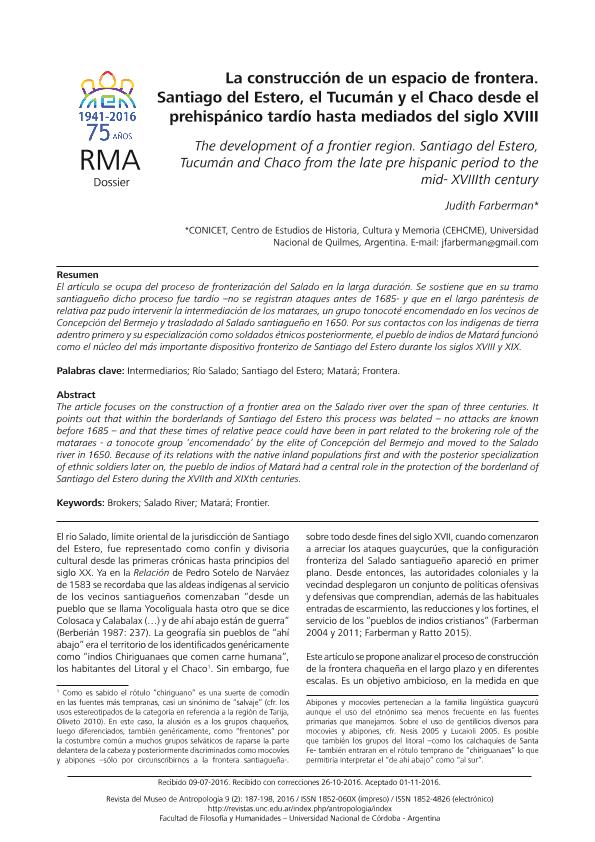Mostrar el registro sencillo del ítem
dc.contributor.author
Farberman, Judith

dc.date.available
2022-11-28T15:12:05Z
dc.date.issued
2016-12
dc.identifier.citation
Farberman, Judith; La construcción de un espacio de frontera: Santiago del Estero, el Tucumán y el Chaco desde el prehispánico tardío hasta mediados del siglo XVIII; Universidad Nacional de Córdoba. Facultad de Filosofía y Humanidades. Museo de Antropología; Revista del Museo de Antropología; 9; 2; 12-2016; 187-198
dc.identifier.issn
1852-060X
dc.identifier.uri
http://hdl.handle.net/11336/179197
dc.description.abstract
El artículo se ocupa del proceso de fronterización del Salado en la larga duración. Se sostiene que en su tramo santiagueño dicho proceso fue tardío no se registran ataques antes de 1685- y que en el largo paréntesis de relativa paz pudo intervenir la intermediación de los mataraes, un grupo tonocoté encomendado en los vecinos de Concepción del Bermejo y trasladado al Salado santiagueño en 1650. Por sus contactos con los indígenas de tierra adentro primero y su especialización como soldados étnicos posteriormente, el pueblo de indios de Matará funcionó como el núcleo del más importante dispositivo fronterizo de Santiago del Estero durante los siglos XVIII y XIX.
dc.description.abstract
The article focuses on the construction of a frontier area on the Salado river over the span of three centuries. It points out that within the borderlands of Santiago del Estero this process was belated no attacks are known before 1685 and that these times of relative peace could have been in part related to the brokering role of the mataraes - a tonocote group `encomendado' by the elite of Concepción del Bermejo and moved to the Salado river in 1650. Because of its relations with the native inland populations first and with the posterior specialization of ethnic soldiers later on, the pueblo de indios of Matará had a central role in the protection of the borderland of Santiago del Estero during the XVIIth and XIXth centuries.
dc.format
application/pdf
dc.language.iso
spa
dc.publisher
Universidad Nacional de Córdoba. Facultad de Filosofía y Humanidades. Museo de Antropología
dc.rights
info:eu-repo/semantics/openAccess
dc.rights.uri
https://creativecommons.org/licenses/by-nc-sa/2.5/ar/
dc.subject
INTERMEDIARIOS
dc.subject
RÍO SALADO
dc.subject
FRONTERA
dc.subject
SANTIAGO DEL ESTERO
dc.subject.classification
Otras Historia y Arqueología

dc.subject.classification
Historia y Arqueología

dc.subject.classification
HUMANIDADES

dc.title
La construcción de un espacio de frontera: Santiago del Estero, el Tucumán y el Chaco desde el prehispánico tardío hasta mediados del siglo XVIII
dc.title
The development of a frontier region: Santiago del Estero, Tucumán and Chaco from the late pre hispanic period to the mid- XVIIIth century
dc.type
info:eu-repo/semantics/article
dc.type
info:ar-repo/semantics/artículo
dc.type
info:eu-repo/semantics/publishedVersion
dc.date.updated
2022-11-27T23:47:08Z
dc.identifier.eissn
1852-4826
dc.journal.volume
9
dc.journal.number
2
dc.journal.pagination
187-198
dc.journal.pais
Argentina

dc.journal.ciudad
Córdoba
dc.description.fil
Fil: Farberman, Judith. Consejo Nacional de Investigaciones Científicas y Técnicas; Argentina. Universidad Nacional de Quilmes. Departamento de Ciencias Sociales. Centro de Estudios de Historia, Cultura y Memoria; Argentina
dc.journal.title
Revista del Museo de Antropología
dc.relation.alternativeid
info:eu-repo/semantics/altIdentifier/url/https://revistas.unc.edu.ar/index.php/antropologia/article/view/15892
dc.relation.alternativeid
info:eu-repo/semantics/altIdentifier/doi/https://doi.org/10.31048/1852.4826.v9.n2.15892
dc.relation.alternativeid
info:eu-repo/semantics/altIdentifier/url/http://www.scielo.org.ar/scielo.php?script=sci_arttext&pid=S1852-48262016000200019&lng=es&nrm=iso&tlng=es
Archivos asociados
